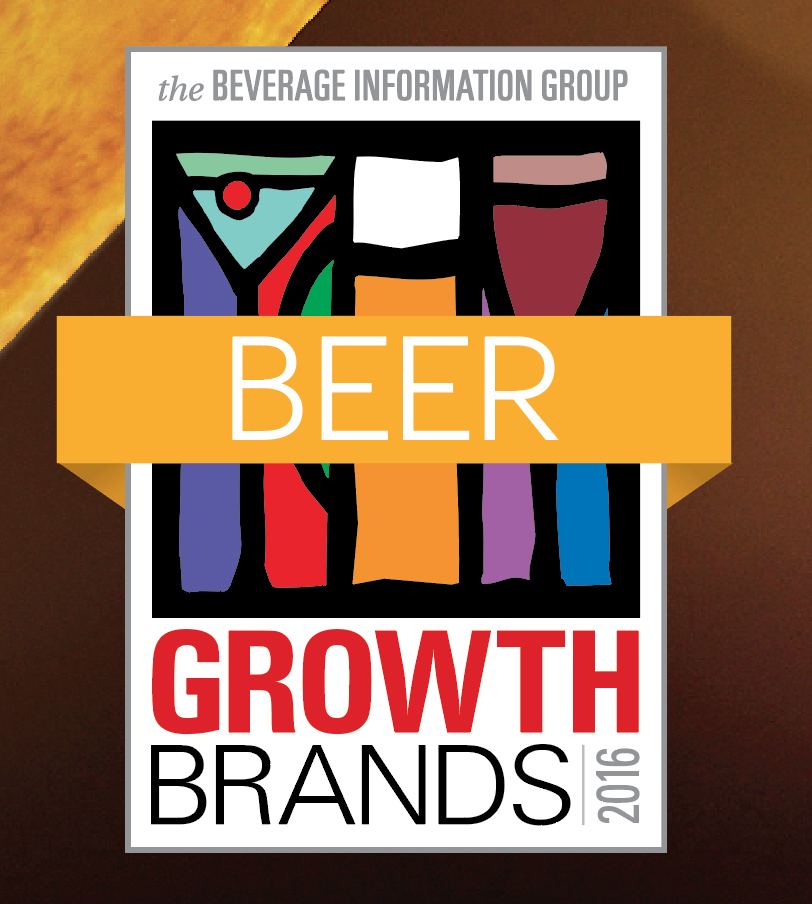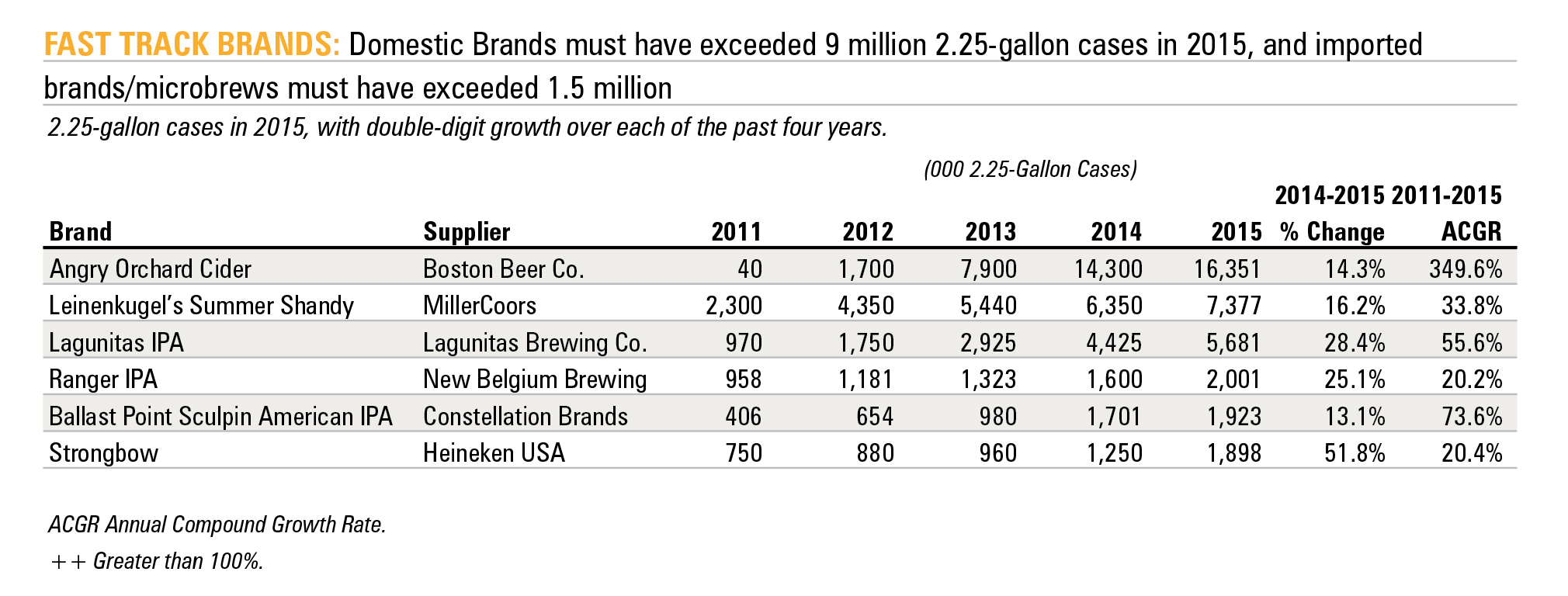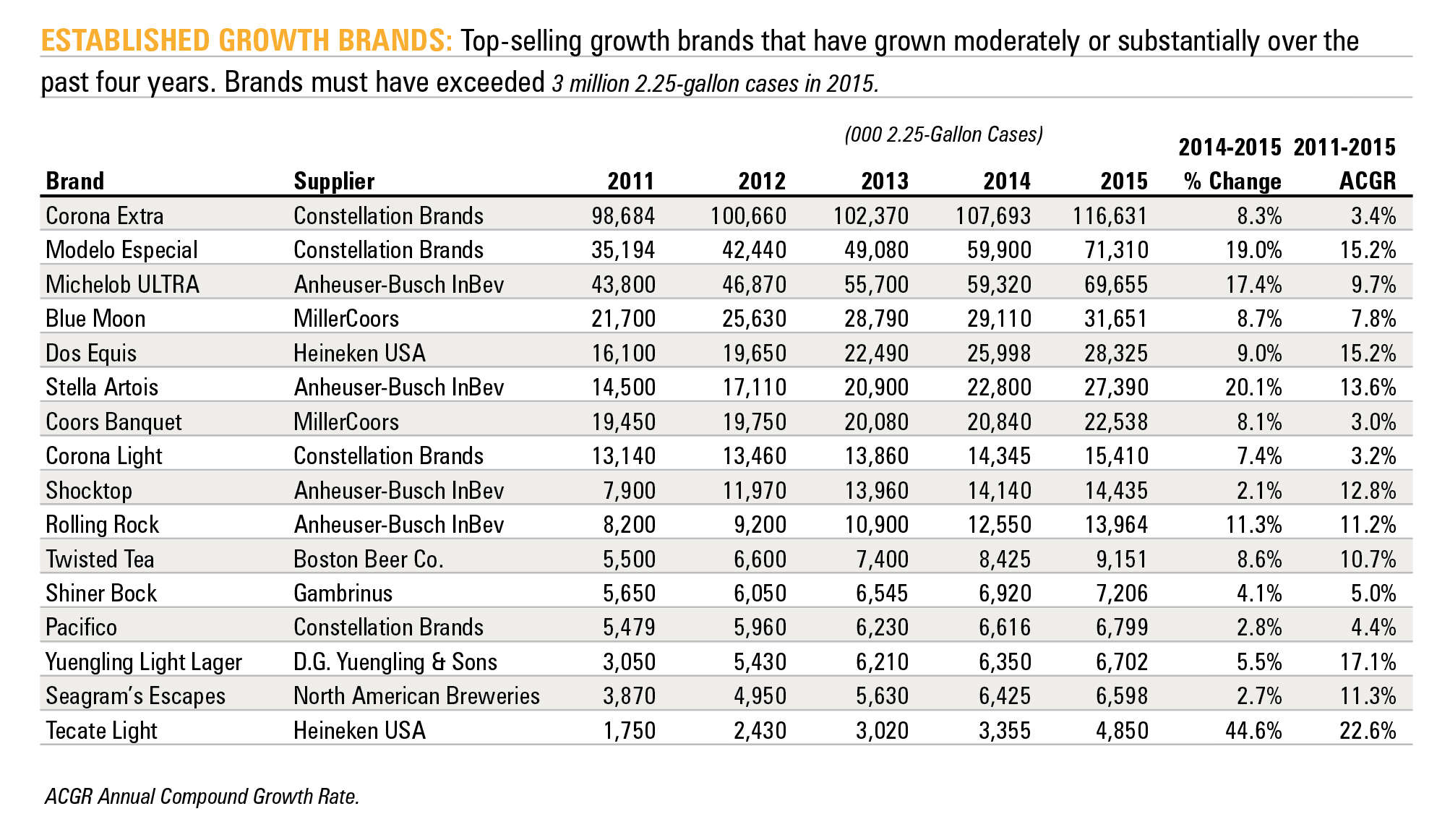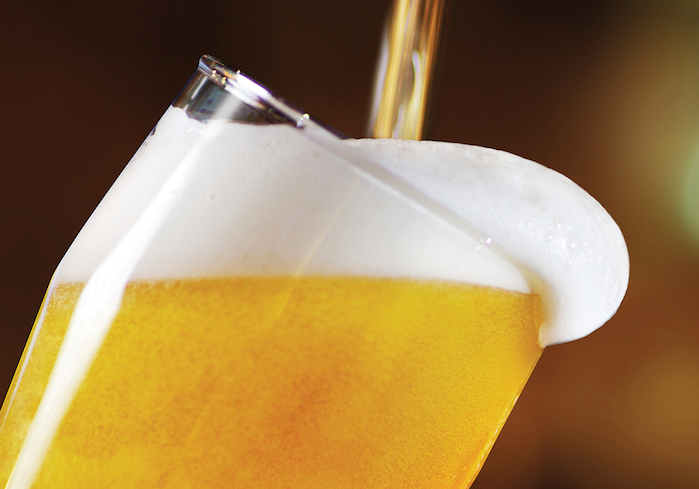The biggest story in beer this past year was soda—hard soda, to be exact. The success of Not Your Father’s Root Beer, which is categorized as a craft beer, started a craze for spiked sodas.
The Small Town Brewery brand made its debut in the Chicago area in 2012; after the company teamed up with Pabst Brewing Co., Not Your Father’s Root Beer was rolled out nationally in spring 2015. A Rising Star Growth Brand, the hard root beer reached 5 million cases last year. A number of hard root beer launches have followed in 2015, including one from the Boston Beer-owned Coney Island Brewing Co., and Anheuser-Busch lnBev’s Best Damn Root Beer.
What else is big in the beer world? According to our 2016 Beer Growth Brand winners, IPAs still reign as a style, Mexican brands remain strong sellers, and while cider has slowed, most of the category’s brands posted strong growth.
Also, the biggest are getting bigger: Not only are A-B InBev and MillerCoors snapping up craft brewers and launching new brands, the two agreed to merge last November—a deal that gives the combined company a third of the global beer market.
 Overall beer consumption increased just 0.1% over 2014, notes Marina Velez, senior product manager at the Beverage Information & Insights Group, which compiles the data used to determine the Growth Brand winners. The biggest increase, not surprisingly, came from craft, which was up 15.1% in 2015 to 279 million 2.25-gallon cases, and fermented malt beverages (FMBs), up 6.7% to 108.2 million cases. The other beer segments all posted declines.
Overall beer consumption increased just 0.1% over 2014, notes Marina Velez, senior product manager at the Beverage Information & Insights Group, which compiles the data used to determine the Growth Brand winners. The biggest increase, not surprisingly, came from craft, which was up 15.1% in 2015 to 279 million 2.25-gallon cases, and fermented malt beverages (FMBs), up 6.7% to 108.2 million cases. The other beer segments all posted declines.
While some analysts expect craft beer’s growth to slow in the next few years, Velez notes that consumers today enjoy products that they can identify with, specifically in terms of how and where it is produced, and brands with a good story. “Craft beer appeals to this trend,” Velez says, and will likely continue to do so. That’s also why the major beer companies will continue to buy small and regional craft brewers.
For the first time in three years, the top Rising Star brand is actually a beer: Goose Island’s IPA. Launched nearly five years ago, the India pale ale from Chicago’s Goose Island Brewery grew nearly 20% to hit 31.7 million 2.25-gallon cases in 2015. Goose Island was acquired by A-B InBev in 2011.
Meanwhile, the second-fastest-growing Rising Star is a lager from Coney Island Brewing, up 35% to 16.2 million cases. Another lager, the bourbon-like Miller Fortune, grew an impressive 45% over 2014 to reach 7.3 million cases in 2015.
Guinness Blonde American Lager, which launched in 2014, also posted solid growth. The beer, made in Latrobe, PA, using American hops and Guinness’ 126-year-old yeast, was up nearly 31% and sold 327,000 cases in 2015.
The overall fastest grower in 2015 is Rising Star Modelo Especial Chelada, which increased nearly 61% in 2015 to reach 4.1 million cases. Described as an authentic “cerveza preparada” brewed in Mexico, it’s a blend of Modelo Especial beer with the flavors of tomato, salt and lime. Launched in October 2013 in select markets, the brand went national in April 2014.
The Lime-a-Ritas, A-B InBev’s Margarita-flavored malt beverage line, continues to show strength among the Rising Stars. The Mango expression remains the biggest seller, up 13% to 9.1 million cases, though the Cran-Brrr-Rita, which launched in late 2013 as a limited-time-only winter seasonal, posted the highest growth rate of the the ’Ritas at 51%. Lime Lemon-Ade-Rita joined the franchise in February 2015.
Redd’s Apple Ale from MillerCoors narrowly edged out Lime Mang-o-Rita for the third spot on the Rising Stars list. While the four-year-old brand’s growth has slowed from 21.8% in 2014 to 12.7% in 2015, it’s the leading FMB on the list.
The Rising Star ciders include Smith & Forge from MillerCoors and Johnny Appleseed and Stella Artois “cidre,” both from A-B InBev.
The hard cider category as a whole grew 9.6% in 2015 to 30.8 million cases sold in 2015, Velez notes, but that’s down quite a bit from the hefty 63.1% growth it posted in 2014.
Fast Track Brands
Indicative of the overall trends in the beer market, our lineup of Fast Track brands this year includes three IPAs, two ciders and a shandy. Fast Track domestic brands must have exceeded 9 million 2.25-gallon cases in 2014, and imported brands/microbrews must have exceeded 1.5 million cases with double-digit growth over the past four years.
The leader, Angry Orchard hard cider, moved over from the Rising Stars list this year. Launched in 2011 by Boston Beer Co., it’s the top-selling cider brand in the U.S. Angry Orchard posted annual compound growth of 349.6% from 2011 to 2015, reaching 16.4 million 2.25-gallon cases in 2015. But the brand’s year-over-year growth rate has slowed considerably from 81% in 2014 to 14.3% in 2015, perhaps an indication that the cider category is maturing
The other cider brand, Heineken USA’s Strongbow, grew nearly 52% to 1.9 million cases in 2015. The company, which brought Strongbow to the U.S. in 2013, introduced a Cherry Blossom expression this past March, which joins its lineup of Gold Apple, Honey, Red Berries and Ginger flavors.
Ballast Point Sculpin American IPA grew 13.1% over 2014, hitting 1.92 million cases in 2015. But the brand’s annual compound growth from 2011 to 2015 was 73.6%.
Ballast Point’s grapefruit-infused version of the Sculpin IPA, introduced in 2013, has been a smash hit as well, and led pineapple and habanero Sculpin spinoffs.
Look for its growth and innovation to continue, as San Diego-based Ballast Point was acquired last year by Constellation Brands.
Sierra Nevada Torpedo, an extra IPA or as the company calls it, a “year-round hop bomb,” slipped off of the list in 2015.
The brand did post 7.9% growth in 2015, but fell just shy of the double-digit growth requirement for a Fast Track, and it was just under the 3 million 2.25-gallon case mark to qualify for an Established Growth brand award.

Established Growth Brands
Established Growth brands are top-selling beers that have grown moderately or substantially in the past four years and that exceeded 2 million 2.25-gallon cases in 2015. Many of the biggest brands have been challenged to grow and therefore aren’t on the list.
Dos Equis moves over from the Fast Track to the Established Growth Brands list; the Mexican lager grew 9.0% to reach 28.3 million cases in 2015. The brand this past spring announced it has decided to retire its “Most Interesting Man” ad campaign after nearly nine years.
Corona Extra, from Constellation Brands, remains the leading Established Growth Brand. The Mexican pale lager grew 8.3% in 2015, reaching 116.6 million cases. That’s an improvement over its 5.2% increase over 2014.
Constellation’s Modelo Especial is catching up to Corona, however. It increased 19% last year, to 71.3 million cases.
The biggest year-over-year increase goes to another Mexican lager-style, Tecate Light, which was up 44.6% over 2014 to reach 4.9 million cases.
Why are the Mexican beer brands so strong?
A growing Hispanic population coupled with the perception that Mexican brews are synonymous with relaxation, beaches and vacation has enabled these key brands to grow, Velez says.
Of the non-Mexican Established Growth brands, Michelob Ultra, Stella Artois and Rolling Rock—all from A-B InBev—posted double-digit growth.

Comeback Brand
The lone Comeback Brand this year is the venerable American brew Pabst Blue Ribbon. Comeback Brands have rebounded in sales to at least the previous level after a recent decline. After falling slightly, from about 37.4 million cases in 2013 to 37.2 million in 2014, sales of Pabst Blue Ribbon increased 2% to nearly 38 million cases in 2015. Millennials and other young legal-drinking-age consumers think it’s cool to drink a classic U.S. brew that dates back to 1844; they’re helping to drive sales of PBR.
With this Comeback Brand award—its 10th award—Pabst joins the Growth Brands Hall of Fame.

Growth Brands Hall of Fame
Our Beer Growth Brands Hall of Fame gained its 10th member this year with the induction of Pabst Blue Ribbon. The Hall of Fame recognizes brands that have won at least 10 Growth Brand Awards since the program’s inception in 1997. Pabst collected its 10th award with the Comeback Brand honor this year.
The classic beer brand started in 1844 when German immigrant Jacob Best and his sons opened the Empire Brewery in Milwaukee. Best was succeeded as company president by his son Phillip, who in 1872 handed down leadership to his son-in-law Frederick Pabst. Pabst eventually renamed the brewery after himself.
The “Blue Ribbon” part of the name derives from the beer winning awards in the late 1800s. To acknowledge these accolades, the company began tying a blue silk ribbon around the bottlenecks of all their Best Select beers.
By 1898, so many bar patrons had ordered the beer by asking for “the one with the blue ribbon” that the nickname had stuck; Pabst changed its name accordingly.
After switching from beer to cheese production during Prohibition, Pabst brewing reemerged strong, and continued to grow. The brand peaked in 1977 with 18 million barrels sold. Corporate upheaval and ownership changes in the 1980s bogged down the company, before hipster interest helped breathe new life into the brand.
Melissa Dowling is editor of Cheers Magazine, a sister publication of Beverage Dynamics. Kyle Swartz is an associate editor for both magazines.





